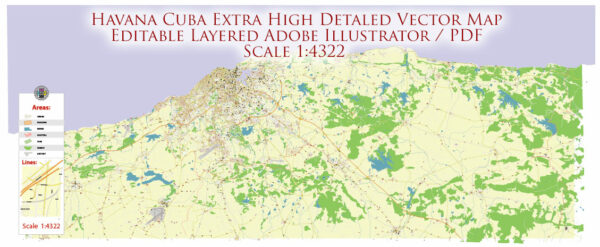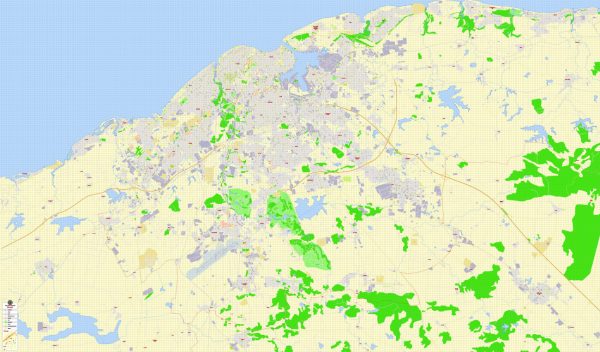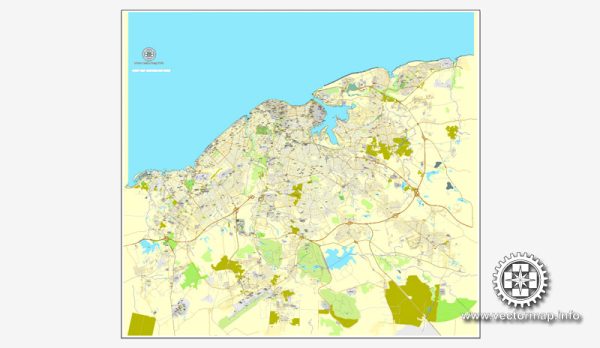The political and economic history of Havana, Cuba, is intricate and has been significantly shaped by colonialism, revolutions, and geopolitical events.
Vectormap.Net provide you with the most accurate and up-to-date vector maps in Adobe Illustrator, PDF and other formats, designed for editing and printing. Please read the vector map descriptions carefully.
Here’s a detailed overview:
Political History:
Pre-Columbian Era:
- Before the arrival of Christopher Columbus in 1492, the island of Cuba was inhabited by the Taíno people.
- Spanish colonization began in the early 16th century, leading to the establishment of Havana in 1515.
Colonial Period:
- Havana became a strategic port for the Spanish Empire, serving as a hub for trade and military operations in the Caribbean.
- The city was frequently attacked by pirates and rival European powers.
- Throughout the colonial period, Havana experienced economic growth but also suffered from periodic epidemics and natural disasters.
19th Century:
- In the 19th century, Havana played a crucial role in the slave trade, with the majority of slaves destined for the sugar plantations in Cuba passing through the city.
- The Cuban independence movement gained momentum in the late 19th century, leading to the Ten Years’ War (1868-1878) and the subsequent Cuban War of Independence (1895-1898) against Spanish rule.
Spanish-American War:
- The sinking of the USS Maine in Havana’s harbor in 1898 played a role in the outbreak of the Spanish-American War.
- The United States defeated Spain, leading to the Treaty of Paris (1898), which ceded control of Cuba to the U.S.
Independence and Republic:
- Cuba gained formal independence in 1902 but remained under the influence of the U.S., particularly through the Platt Amendment, which granted the U.S. the right to intervene in Cuban affairs.
- Political instability marked the early decades of the Cuban Republic, with a series of coups and changes in leadership.
Fulgencio Batista:
- In 1952, Fulgencio Batista seized power in a coup, establishing an authoritarian regime.
- Batista’s rule was marked by corruption, repression, and close ties to American organized crime.
Cuban Revolution:
- Led by Fidel Castro, the Cuban Revolution began in 1953 and culminated in the overthrow of Batista in 1959.
- The revolution established a socialist government in Cuba, with Fidel Castro as its leader.
Cold War Era:
- The Cuban government, under Castro’s leadership, aligned itself with the Soviet Union, leading to strained relations with the United States.
- The Cuban Missile Crisis in 1962 brought the world to the brink of nuclear war.
Post-Cold War Period:
- With the collapse of the Soviet Union in 1991, Cuba faced economic hardships due to the loss of Soviet support and the imposition of a U.S. economic embargo.
Economic History:
Colonial Economy:
- Havana’s economy in the colonial period was centered around sugarcane plantations and the slave trade.
- The city became a major trading center, with goods flowing through the port.
19th Century:
- The 19th century saw the expansion of sugar production, with Havana becoming a key player in the global sugar trade.
- Tobacco also became a significant industry, with the development of the Cuban cigar industry.
Republic Era:
- In the early 20th century, the Cuban economy remained dependent on sugar, with U.S. companies playing a prominent role.
- Tourism started to emerge as a significant economic factor.
Socialist Era:
- After the Cuban Revolution, the government nationalized industries, including sugar and foreign-owned businesses.
- The Cuban economy became closely tied to the Soviet Union, receiving economic aid and trade benefits.
Special Period:
- The collapse of the Soviet Union in 1991 led to an economic downturn known as the “Special Period,” characterized by shortages, economic decline, and increased poverty.
Economic Reforms:
- In the 21st century, Cuba began implementing economic reforms, opening up some sectors to private enterprise.
- The normalization of relations with the U.S. in 2014 brought the possibility of increased trade and investment.
Despite facing economic challenges, Havana remains a vibrant and culturally rich city, with a complex history that continues to shape its political and economic landscape.




 Author: Kirill Shrayber, Ph.D.
Author: Kirill Shrayber, Ph.D.